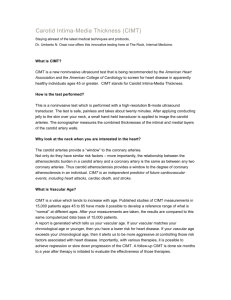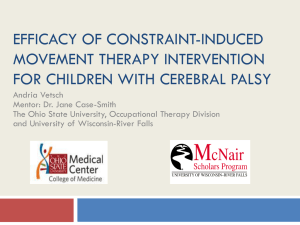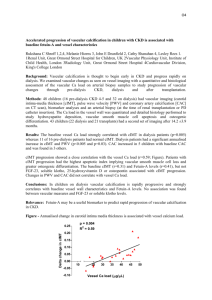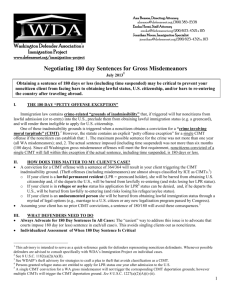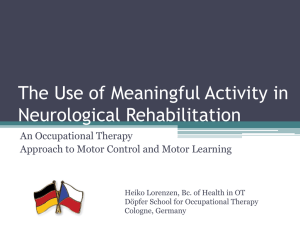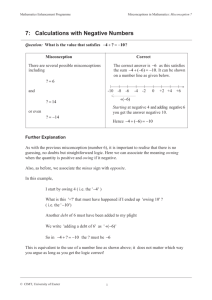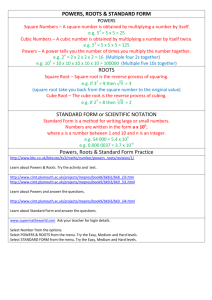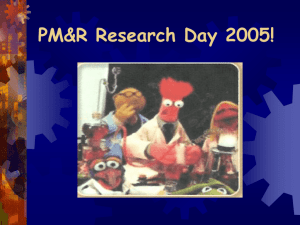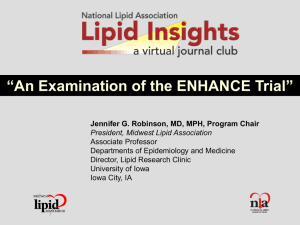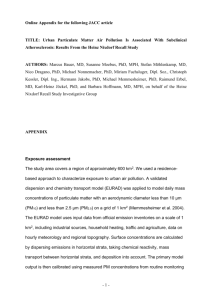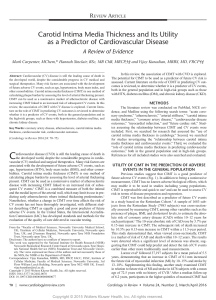PowerPoint - GRECC Audio Conferences
advertisement
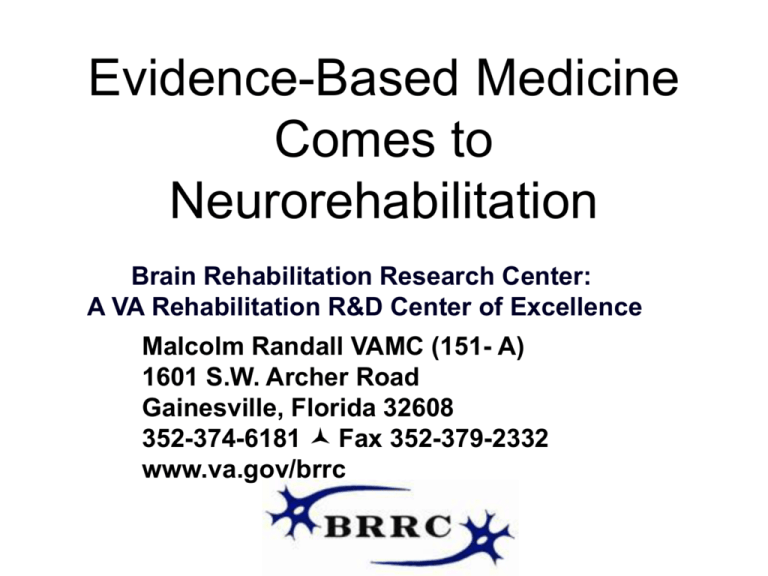
Evidence-Based Medicine Comes to Neurorehabilitation Brain Rehabilitation Research Center: A VA Rehabilitation R&D Center of Excellence Malcolm Randall VAMC (151- A) 1601 S.W. Archer Road Gainesville, Florida 32608 352-374-6181 Fax 352-379-2332 www.va.gov/brrc Welcome Presenters: Stephen E. Nadeau, MD. Medical Director BRRC, Chief of Neurology Malcom Randal NF/SG VAMC University of Florida Neurology snadeau@ufl.edu Sandra E. Davis, Research P.T. BRRC University of Florida Physical Therapy sandra.davis2@va.gov Lorie G. Richards, OTR/L, PhD Research Scientist BRRC University of Florida Occupational Therapy lrichard@phhp.ufl.edu Objectives • As a Participant you will be able to: * describe EBM in stroke rehabilitation * identify individuals for constraint induced movement therapy (CIMT) * list key components of CIMT * implement a CIMT session * explain the scientific basis for CIMT * identify limitations in evidence for CIMT Introduction to Constraint Induced Movement Therapy CIMT EXCITE TRIAL Wolf SL et al. Effect of constraint-induced movement therapy on upper extremity function 3 to 9 months after stroke. JAMA 2006;296:2095-2104 • Prospective, randomized, parallel group, multicenter, phase III, single blind trial of 2 weeks of CIMT, 3 & 9 months after acute stroke • Subjects: – CIMT: N = 106 – Usual and customary care : N = 116 • Inclusion criteria: – High functioning: 20˚ wrist ext, 10˚ finger ext. – Low functioning: 10˚ wrist ext, 10˚ ext. thumb & ≥ 2 other fingers. – Motor Activity Log (MAL) < 2.5 • CIMT: up to 6 hrs/day + mitt worn 90% of waking hrs. • Outcome measures: Wolf Motor Function Test MAL- Quality of motion at 1-year. EXCITE Trial First: Identify Individuals for CIMT • CIMT is a beneficial treatment for patients post stroke exhibiting some active wrist and hand movement. Wolf et al 2006,Dromerick et al 2000, Van der Lee et al1999 Minimum Motor Criteria: Active extension must be repeated 3x in one minute: From a relaxed resting position, Not from a neutral wrist position. At least 10 degrees: wrist, thumb and 2 digits Include Key Components of CIMT • Add these elements to each session: * Massed Repetition * Graded/progressed activities * Objective Feedback * Restraint of the less involved UE * Intensive Practice: Original CIMT included 6 hours/day for 5 days a week for 2 weeks What does a CIMT Session Look Like? • Choose Shaping (lower functioning) or Task Practice (higher functioning) Shaping: Components of the task are made more difficult in a more structured way to attain the task. Detailed feedback & progress only when attain set goal Example: reach - to grasp - to lift a glass – to drink Task Practice: Functionally based activities performed continuously 15-20 minutes or until the task is attained. Example: fix a sandwich & eat lunch More general feedback & graded progression To Progress: Add specific challenges i.e. speed, height, distance, weight, #’s, dual task, quality of movement Choose CIMT tasks to match the Individual Design CIMT Menu of Unique Tasks • To meet the unique individual’s needs: * impairment level * interests * roles inventory * meaningful activities * functional needs * strength * coordination * range of motion * sensation * personal goals * endurance * sense of humor Creative Considerations for CIMT and modified mCIMT *Setting *Acuity *Length of Stay *Staffing *Support *Modifications *Home Program *Charge and Reimbursement *Legal and Ethical considerations Standardized tests to take to clinic • Measure your Outcomes! MAL- Amount & Quality Box and Blocks Fugl Meyer Wolf Motor Function Kinematics Actual Amount Use Test Accelerometry Quality of Motion QoL- SIS Caregiver Strain Compliance Measures • Translational Package Morris,Taub,Mark,2006 * Contract 90% mitt wearing * Diary * Coach agreement * Daily cues: Motor Activity Log * Home Practice * Weekend Practice * Daily Schedule * Agreed upon appointments * Agreed upon time to remove mitt Constraint Induced Movement Therapy • A family of therapies • Developed from deafferented monkey studies (Knapp, Taub, et al., 1958; Taub, 1976, 1977) – Without sensation, monkey did not use the limb – Would use the arm if the other arm were restrained – Restraint of 1-2 days = revert after restraint removal, but not after 1-2 weeks – Shaping also increased ability and use of limb Constraint Induced Movement Therapy • Developed to improve motor skill and to decrease learned non-use Injury Compensatory Behavior patterns Unsuccessful attempts to move Positive Reinforcement Punishment (pain, can’t) Behavioral suppression Compensatory behavior strengthened 5 4 3 2 1 0 -1 -2 -3 MAL Wolf time 5 4.5 4 3.5 3 2.5 2 1.5 1 0.5 0 MAL-6 MAL-3 pre post f/u (Sterr, et al., 2002) Does it need to be given 6 hours every day? 3.4 Scores on the Amount of Use Scale (MAL) Scores on the Wolf Functional Ability Scale 3.5 3.35 3.3 3.25 3.2 3.15 3 2.5 2 1.5 1 0.5 0 Baseline 3.1 Baseline Midpoint Post Midpoint Post 6-months (Dettmers, et al., 2005) 6-months ACUTE STROKE Traditional therapy: Compensatory ADLs, ROM, strengthening, dexterity practice mCIMT – 1/2 hrs/d 3x/wk shaping, 5 hr/d mitt Page, et al., 2005 ACUTE STROKE Traditional therapy: Compensatory ADLs, ROM, strengthening Low CIMT – 2 hrs/d shaping, 5 hr/d mitt High CIMT – 3 hr/d shaping, mitt 90% waking hrs Dromerick, et al., 2009 Cortical Map Reorganization Proximal Distal (Kleim et al, 2004) Is there evidence that CIMT changes the brain? • 2 most common methods: – Transcranial Magnetic Stimulation (TMS) – Functional Magnetic Resonance Imaging (fMRI) Is there evidence that CIMT changes the brain? (Hamzei, et al., 2006) Participants with intact M1 and MEPs at baseline Participants with lesioned M1 and disturbed MEPs at baseline CIMT now Paired • With other Therapies: * Drugs * Strengthening * Rhythm Cues Remaining Questions • Future Research Needs to Demonstrate * What is the Best CIMT Schedule: - Distributed versus Massed - # of Hours - Maintenance of the gains Summary • Evidence shows: - CIMT is efficacious - Variations of the original protocol are efficacious and can translate to clinic - More therapy is generally better - CIMT is reimbursable Thank you! Questions & Discussion CE Credit • For any questions about the monthly GRECC Audio Conference Series please contact Tim Foley at tim.foley@va.gov or call (734) 222-4328 • To evaluate this conference for CE credit please obtain a ‘Satellite Registration’ form and a ‘Faculty Evaluation’ form from the Satellite Coordinator at you facility. The forms must be mailed to EES within 2 weeks of the broadcast
